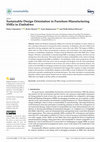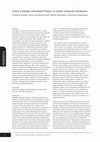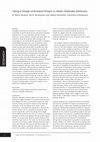Research Papers by Richie Moalosi

Sustainability, 2023
Small and Medium Enterprises (SMEs) have become the backbone of many nations as they contribute i... more Small and Medium Enterprises (SMEs) have become the backbone of many nations as they contribute immensely to the growth of their economies. In Zimbabwe, they have filled in the gap left by the big companies after the economic crisis of the early 2000s. The impact of SMEs is small when we look at their environmental, economic, and social impact, but when rouped, it becomes a considerable contribution. Evidence from the literature shows that SMEs have a short
lifespan. Therefore, sustainability in manufacturing SMEs in emerging economies and their survival
strategy have been discussed. This study aimed to examine sustainability in the context of design in furniture-manufacturing SMEs in Zimbabwe. The qualitative study used a purposively selected sample of ten SMEs where the owner and/or manager and designer were the main participants. Observations were also conducted on-site in all ten cases where evidence was noted for analysis. The study reveals that SMEs in emerging economies face many challenges, such as a lack of finance, skilled human resources, and management commitment that hamper their capacity to adopt sustainable design in their practices. Sustainability adoption in these SMEs is more adherent to the regulatory framework, especially considering the environmental aspect. The study concludes by recommending that policymakers in government should create tax rebate incentives that should be awarded to those SMEs that score highly in all three pillars of sustainability.
Faculty of Built Environment and Engineering, 2001
Page 1. COVER SHEET This is the author version of article published as: Moalosi, Richie (2001) Bo... more Page 1. COVER SHEET This is the author version of article published as: Moalosi, Richie (2001) Botswana's Tertiary Design and Technology Curriculum Model. In Proceedings International Technology Education Conference, Durban: South Africa. ...
Faculty of Built Environment and Engineering, 2002
ABSTRACT For the last three decades Industrial Designers have been blamed for designing for &... more ABSTRACT For the last three decades Industrial Designers have been blamed for designing for 'greed' and not for 'need'. The current mode of design practice is a reflection of the problems of Design, the Designers and the society. This paper looks at some of the paradoxes that ...
Design and Technology Education an International Journal, 2008
Abstract In this paper the background to the introduction of design and technology in Botswana&#x... more Abstract In this paper the background to the introduction of design and technology in Botswana's schools is examined. The introduction was flawed as it left the foundations years weak, that is design and technology was first introduced at senior secondary school and subsequently ...

Design and Technology Education an International Journal, Feb 20, 2012
Nowadays universities are required not only to impart knowledge of specific disciplines but also ... more Nowadays universities are required not only to impart knowledge of specific disciplines but also generic graduate attributes such as communication, problem-solving, teamwork, creative thinking, research and inquiry skills. For students to attain these generic skills, educators are encouraged to use learner-centred approaches in teaching. Project-based learning is one such an approach which promotes self-directed and lifelong learning capabilities, equips students with transferrable knowledge and skills that are essential to the work environment, intertwines theory and practice, gives students the opportunity to gain a deep understanding of concepts and potentially allows them to solve the society's problems. A case study was conducted at the University of Botswana with Design students to assess the attainment of the graduate attributes after designing packages for a small entrepreneur producing frozen vegetables. The results indicate that the following graduate skills were either rated very good or excellent: self-directed, lifelong learning, critical and creative thinking, problem-solving, organisational and teamwork, communication, entrepreneurship, information and communication technology knowledge and skills. This shows that project-based learning can impart the skills and knowledge that the labour market needs. The results also provide an opportunity for educators to critically reflect on the type of projects given to students in relation to the attainment of graduate attributes.

This paper presents the intermediate results of the Learning Network on Sustainable Energy System... more This paper presents the intermediate results of the Learning Network on Sustainable Energy Systems (LeNSes) an African-European multi-polar network for curriculum development on Design for Sustainability (DfS) focused on Distributed Renewable Energy (DRE) and Sustainable Product-Service Systems (S.PSS). The paper discusses the convergence between the S.PSS and DRE models as promising approaches to provide sustainable energy solutions for all by increasing its access and improving efficiency in use. Currently, the project partners are collaboratively developing new curricula focused on these combined approaches. The paper examines the S.PSS and DRE models and how they can be used to develop and implement sustainable energy solutions for all within the African context. The research hypothesis is that S.PSS could be applied to DRE to offer a range of benefits such as: economic, environmental and socio-ethical. The paper describes some of the project activities that includes: developmen...

This paper presents the intermediate results of the Learning Network on Sustainable Energy System... more This paper presents the intermediate results of the Learning Network on Sustainable Energy Systems (LeNSes) an African-European multi-polar network for curriculum development on Design for Sustainability (DfS) focused on Distributed Renewable Energy (DRE) and Sustainable Product-Service Systems (S.PSS). The study identified the convergence between the S.PSS and DRE models as promising approaches to provide sustainable energy solutions for all by increasing its access and improving efficiency. Currently, the project partners are collaboratively developing new curricula focused on these combined approaches. The paper examines the S.PSS and DRE models and how they can be used to develop and implement sustainable energy solutions for all within the African context. The research hypothesis is that S.PSS could be applied to DRE to offer a range of benefits such as: economic, environmental and socio-ethical. The paper describes how the study aims to: develop a new modular and adaptable pac...

Nowadays universities are required not only to impart knowledge of specific disciplines but also ... more Nowadays universities are required not only to impart knowledge of specific disciplines but also generic graduate attributes such as communication, problem-solving, teamwork, creative thinking, research and inquiry skills. For students to attain these generic skills, educators are encouraged to use learner-centred approaches in teaching. Project-based learning is one such an approach which promotes self-directed and lifelong learning capabilities, equips students with transferrable knowledge and skills that are essential to the work environment, intertwines theory and practice, gives students the opportunity to gain a deep understanding of concepts and potentially allows them to solve the society’s problems. A case study was conducted at the University of Botswana with Design students to assess the attainment of the graduate attributes after designing packages for a small entrepreneur producing frozen vegetables. The results indicate that the following graduate skills were either ra...

Globalisation has added pressure to an era of tough market competition around the world. Enterpri... more Globalisation has added pressure to an era of tough market competition around the world. Enterprises are compelled to gain recognition and benefit from penetrating either local or global markets. In most cases, entities use a strong branding strategy as a competitive tool. Every successful enterprise needs to be set up around a distinctive idea of some kind to distinguish itself effectively and efficiently from others and branding gives a company such an image and identity. It is important to have some visual or verbal symbol, which is used as an identity. Furthermore, branding promotes structure, strategies and ambitions of running an effective growing business. For a business to sustain its existence in the market, it needs to effectively position itself appropriately to target the correct customer. The University of Botswana design students in collaboration with some Small Micro Enterprises conducted a case study. A case study approach was deemed appropriate for this study becaus...
How can this creative process be applied to the design process? Often people present linear, inte... more How can this creative process be applied to the design process? Often people present linear, inter-linking, cyclic structures of the design process without giving much detail about each stage. If there is no common understanding, the design process would be interpretated differently and in some cases wrongly. At the end of the day, students are the ones who suffer. This paper would attempt to address the contents of the design process so that our students would be more creative than before.

Lack of an innovative programme aimed at instilling a culture of continuous innovation among Bots... more Lack of an innovative programme aimed at instilling a culture of continuous innovation among Botswana’s Small Micro Enterprises (SME) has been cited as an impediment for the growth of this sector. SME are open to domestic and foreign competition, and mostly threatened by imports from other countries. The successful exploitation of new innovative ideas has driven economic progress of many countries. The challenge for Botswana’s SME is to compete on the basis of unique value and innovation. Innovation matters because it means higher quality and better products, more efficient services and higher standards of living. The absence of design and innovation can lead to business stagnation and loss of jobs. It is against this background that the researchers conducted a case study to audit the level of innovation in Botswana’s SME sector. Botswana’s economic diversification and growth is based on the success of the SME, whose success in turn is based on their innovative abilities. A case stu...
Advanced Curriculum Innovations, 2012
International Journal of Affective Engineering, 2014
Educational Research, 2011
Skip to content. Taylor & Francis Online: Librarians; Authors & E... more Skip to content. Taylor & Francis Online: Librarians; Authors & Editors; Societies. Register; Sign in; Mobile. Home; Browse; Products; Redeem a voucher; Shortlist; Shopping Cart Cart. The online platform for Taylor & Francis Group content. Search. Advanced Search Within current journal Entire site. Home > List of Issues > Table of Contents > List of referees who have given help in 2009/10. Browse journal. View all volumes and issues. Current issue. Most read articles. Most cited articles. Authors and submissions. Call for papers. Instructions for authors. ...
For the last three decades Industrial Designers have been blamed for designing for 'greed&#x... more For the last three decades Industrial Designers have been blamed for designing for 'greed' and not for 'need'. The current mode of design practice is a reflection of the problems of Design, the Designers and the society. This paper looks at some of the paradoxes that ...
This paper investigates the influence of culture on product design in Botswana, a topic on which ... more This paper investigates the influence of culture on product design in Botswana, a topic on which there little previous research. It is argued that product innovation should be assimilated within the context of Botswana's own culture but it has been observed that designers have not yet been able to encode cultural phenomena to the same extent as physical ones. The basis of this paper is that there is little in-depth research that can assist designers to encode socio-cultural variables in their design practice.
Moalosi, Richie and Popovic, Vesna and Hickling-Hudson, Anne R. (2007) Strategies for infusing cu... more Moalosi, Richie and Popovic, Vesna and Hickling-Hudson, Anne R. (2007) Strategies for infusing cultural elements in product design. In Daniels, C., Eds. Proceedings 5th International Design Education Forum of South Africa Conference - FLUX: Design Education in a Changing ...
International Journal of Technology & Design Education, Sep 5, 2008
There is little in-depth research that can assist designers to use culture as a catalyst for desi... more There is little in-depth research that can assist designers to use culture as a catalyst for designing innovative products within Botswana’s context. The concept of culture and design are intertwined, thus modifications stemming from cultural evolution
both reflect and determine developments in design. The paper discusses an experimental design approach conducted at the University of Botswana and participants challenge was to
transform and encode socio-cultural factors into product design features. The paper concludes by discussing a model which has shown one way concerning how to consciously specify, analyse and integrate socio-cultural factors in the design process.
This paper explores the relationship between culture and human-centred design in Botswana, a topi... more This paper explores the relationship between culture and human-centred design in Botswana, a topic on which there is little previous research. The paper develops a framework of cultural analysis, comparing traditional with contemporary variables in order to develop a set of core variables that can be applicable to product design. Content analysis methodology was used to extract traditional variables from Botswana folktales, and qualitative data analysis methods were used to analyse contemporary variables. The results indicated that there is more emphasis on non-material than material variables. The paper concludes with a discussion of how to develop cultural strategies that will improve the potential of using human-centred design approach as the key to designing culturally sensitive products.

Uploads
Research Papers by Richie Moalosi
lifespan. Therefore, sustainability in manufacturing SMEs in emerging economies and their survival
strategy have been discussed. This study aimed to examine sustainability in the context of design in furniture-manufacturing SMEs in Zimbabwe. The qualitative study used a purposively selected sample of ten SMEs where the owner and/or manager and designer were the main participants. Observations were also conducted on-site in all ten cases where evidence was noted for analysis. The study reveals that SMEs in emerging economies face many challenges, such as a lack of finance, skilled human resources, and management commitment that hamper their capacity to adopt sustainable design in their practices. Sustainability adoption in these SMEs is more adherent to the regulatory framework, especially considering the environmental aspect. The study concludes by recommending that policymakers in government should create tax rebate incentives that should be awarded to those SMEs that score highly in all three pillars of sustainability.
both reflect and determine developments in design. The paper discusses an experimental design approach conducted at the University of Botswana and participants challenge was to
transform and encode socio-cultural factors into product design features. The paper concludes by discussing a model which has shown one way concerning how to consciously specify, analyse and integrate socio-cultural factors in the design process.
lifespan. Therefore, sustainability in manufacturing SMEs in emerging economies and their survival
strategy have been discussed. This study aimed to examine sustainability in the context of design in furniture-manufacturing SMEs in Zimbabwe. The qualitative study used a purposively selected sample of ten SMEs where the owner and/or manager and designer were the main participants. Observations were also conducted on-site in all ten cases where evidence was noted for analysis. The study reveals that SMEs in emerging economies face many challenges, such as a lack of finance, skilled human resources, and management commitment that hamper their capacity to adopt sustainable design in their practices. Sustainability adoption in these SMEs is more adherent to the regulatory framework, especially considering the environmental aspect. The study concludes by recommending that policymakers in government should create tax rebate incentives that should be awarded to those SMEs that score highly in all three pillars of sustainability.
both reflect and determine developments in design. The paper discusses an experimental design approach conducted at the University of Botswana and participants challenge was to
transform and encode socio-cultural factors into product design features. The paper concludes by discussing a model which has shown one way concerning how to consciously specify, analyse and integrate socio-cultural factors in the design process.
reuse and conservation of water which is a precious resource in Botswana. At the end of the project, a survey was conducted for students to score the level of the perceived attainment of a set of graduate attributes presented to them. The results show that the
top six graduate attributes perceived to have been attained by students of both universities include: impact on professional development, opportunities for collaborative work, social skills, design with empathy, opportunities for intellectual curiosity, and critical thinking skills. Giving students’ real-life, meaningful projects enabled them to simulate the required graduate attributes when they work with different stakeholders. The chapter concludes that universities should review their teaching and learning pedagogies to make them more relevant, appropriate and effective to address the integration and the attainment of graduate attributes so as to produce a competent future workforce.